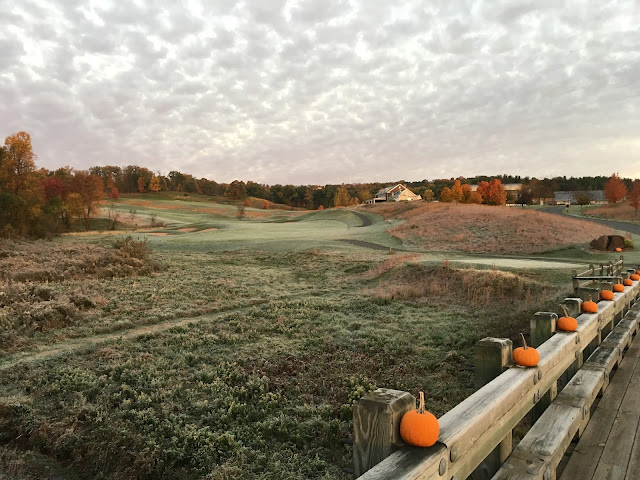As promised, the updates will be a little more frequent than they have over the last year. The course has been playing great. The weather has been unusually dry and mild so has provided great conditions for fall golf. The yearly battle with the leaves seemed to take longer than normal but the high winds that ushered in the winter weather over the last few days have taken care of the remainder of them. The next job on the list is to get the fescues and brush cut before the snow arrives.
The big project this fall was the renovation of the driving range tees. The tees were built in 2004 and over the years the surface has raised 6-8" from divot repair and the topdressing needed to keep them smooth and level. Over the last two seasons the complaints on the tee conditions greatly increased which was not surprising considering their age. Although the life span can vary - based on my research - most clubs look at resurfacing every 5-6 years so the build up and poorer quality surface is not as noticeable.
Lower Tee in early summer
Upper tee in early summer
Removing the topdressing build-up
Final grading before laser levelling
There was more material than we first thought!
The secondary issue was the club has become significantly busier over the last few seasons resulting in a lot more wear on the driving range tees. The mild spring this year didn't help either, as the tee was being used before the turf woke up, so there was no healing; therefore they started the season in poor shape. The solution was to add mats that can be hit from over the winter and not damage the turf. Additionally the mats will be used for outings and on days that are not traditionally busy to help minimize the wear on the real turf.
Among the complaints was that the driving range tees did not play like a fairway; which was something that is difficult to achieve as the range tees are sand based like a course teebox, whereas the fairways are grown on native soil. A sand based tee is beneficial as it drains well and in summer if it dries out it is not too difficult to push tees into. The turf on the range tees is bentgrass just like the tees and fairways on the course. For consistency it was used again to make them as close to course conditions as possible. Some other grass types that heal quicker were discussed but they would not play like the course.
The west end of the tee where the old bunkers were filled in to create un-level lies for practice
The tees were covered to help speed up germination - the bentgrass seed has germinated and will provide a head start for the spring
The two little practice bunkers were filled in and a larger more usable one was built in front of the tees. The new bunker was designed to provide different shot angles over low and high faces. The area where the old bunkers were filled in was regraded with the native soil to provide an area to practice uneven lies which provides more realistic fairway shots. The lip of the new bunker was built using Ecobunker (marketed as Permaedge in the US). Old synthetic turf is used instead of real sod to create the lip. This helps minimize erosion and contamination of the sand, and when coupled with a liner like Blinder greatly increases the lifespan of the sand and therefore the bunker.
Shelling the bunker out and creating the lip
Adding drainage to the bunker
Modified stone base below the liner
Blinder bunker being installed
Ecobunker (marketed as Permaedge in the USA) being installed
Vacuuming the debris out of the liner to prevent contamination
Final grading
Final cleaning before sand
The real turf is laid over the Ecobunker and will be trimmed back once it knits
As always please let me know if you have any questions: alan@ledgerockgolf.com
I wish everyone a Happy Thanksgiving!





























































